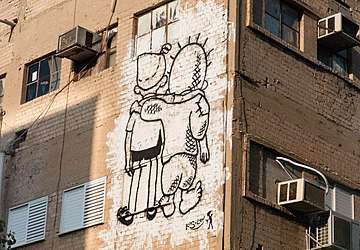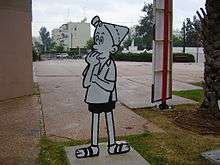The Peace Kids (mural)

The Peace Kids is a mural that was painted by the Israeli graffiti crew, Kis-Lev, on the side wall of a large building in Tel Aviv, Israel in September 2014. Simultaneously, the crew also recreated the work in the Palestinian city of Bethlehem, on the Israeli West Bank barrier, with the cooperation of local Palestinian artists. Both artworks are 275 inches (700cm) high by 118 inches (300cm) wide,[1] and depict Israeli Srulik and Palestinian Handala embracing one another. The murals received much criticism.[2]
Background
Srulik


Srulik (Hebrew: שרוליק, IPA: [ˈsʁu.lik]) is a cartoon character symbolizing Israel. The character was created in 1956 by the Israeli cartoonist Kariel Gardosh, known by his pen name Dosh.
The cartoon appeared for many years in the newspaper Maariv. Yosef Lapid, Dosh's colleague on the editorial board of Maariv, described Srulik as an icon of Israel in the same way that Marianne and Uncle Sam were respectively icons of France and the United States. Srulik is a common nickname for "Yisrael" (Israel).
Srulik is generally depicted as a young man wearing a tembel hat, Biblical sandals, and khaki shorts. Srulik is a pioneering Zionist, a lover of the land of Israel and its soil, a dedicated farmer who in time of need puts on a uniform and goes out to defend the state of Israel. Dosh drew Srulik in cartoons on current events for Maariv, and also for various "specials" and occasions of the young state. During wartime, Srulik put on a uniform and was drafted to raise the national morale.
Many have pointed out Srulik's function as an antithesis of the antisemitic caricatures which appeared in Der Stürmer and other European and Arab journals. As against the stereotype of the weak or cunning Jew that was propagated by Joseph Goebbels, Dosh — a Holocaust survivor — drew a proud, strong and sympathetic Jewish character. The journalist Shalom Rosenfeld, editor of Maariv in 1974-1980, wrote:
Srulik became not only a mark of recognition of [Dosh's] amazing daily cartoons, but an entity standing on its own, as a symbol of the Land of Israel - beautiful, lively, innocent ... and having a little chutzpah, and naturally also of the new Jew. Because of our history and our religion and the relations between us and the nations that absorbed us in their countries and cultures, stereotypes were created, mostly not so positive of the Jewish man. In the works of the greatest artists of prose, poetry and painting these stereotypes moved between a Wandering Jew, restless, tragic and pathetic and the hunchbacked, crooked-nosed, fleshy-lipped Jew with a pack of banknotes in his pockets, a prototype of the Shakespearean Shylock and The Jew Süss, in Goebbelsian interpretation, and in the modern times of many caricaturists in the Arab countries.
— Shalom Rosenfeld, Maariv, February 2, 2001
Handala
Handala, also known as Handhala (Arabic: حنظلة), is the most famous caricature by Palestinian cartoonist Naji al-Ali. Al-Ali has been described as the greatest Palestinian cartoonist and probably the best-known cartoonist in the Arab world.
Al-Ali first depicted Handala as a ten-year-old boy in Al-Siyasa in Kuwait in 1969.[3] The figure turned his back to the viewer from the year 1973, and clasped his hands behind his back. Al-Ali explained that the ten-year-old represented his age when forced to leave Palestine and would not grow up until he could return to his homeland; his turned back and clasped hands symbolised the character's rejection of "outside solutions".[4]Handala wears ragged clothes and is barefoot, symbolising his allegiance to the poor. In later cartoons, he is actively participating in the action depicted not merely observing it.[4]
Handala became the signature of Naji al-Ali's cartoons and remains an iconic symbol of Palestinian identity and defiance. Handala has also been used as the web mascot of the Iranian green movement. Al-Ali remarked that "He was the arrow of the compass, pointing steadily towards Palestine. Not just Palestine in geographical terms, but Palestine in its humanitarian sense—the symbol of a just cause, whether it is located in Egypt, Vietnam or South Africa."[5]
Creating the mural


Artist Jonathan Kis-Lev first spoke about creating the mural in 2004, while studying in a United World College for peace in Canada.[2] He explained, "I knew of the importance of Srulik to Israelis, as I grew up in Israel seeing Srulik's image constantly. We all love him. I first encountered Handala when visiting the Palestinian Territories in my teens and seeing just how emotional and meaningful Handala is for Palestinians. I thought that juxtaposing the two together could be a powerful visual message to represent the hope for peace in the Middle East."[1]
In 2013 Kis-Lev joined hands with three artists: Palestinian Moodi Abdallah, and Israeli Roman Kozhokin and Itai Froumin. Froumin helped Kis-Lev creating the final image of the embrace, properly showing Srulik from the back, while keeping his iconic hair twirl showing. Artist Roman Kozhokin helped creating the stencil and spraying the work in Tel Aviv. Artist Moodi Abdallah helped creating the work in Bethlehem.[2]
For the creation of the mural in Tel Aviv, the Kis-Lev crew was assisted by a crane. For the creation of the mural on the separation wall in Bethlehem, the crew was assisted by several ladders.
Reception and criticism
The work was received with mixed criticism. It was called "naive" and "delusional" by both Israeli and Palestinians. Left wing activists lauded the work for its simplicity, conveying a "message of hope."[6] Israeli artist and Bezalel Academy of Arts professor Michel Kichka praised the work:
"I, too, have seen this large-scale graffiti in South Tel Aviv. It is doubtful whether such a painting could have been created in the lives of Al-Ali and Dosh. Dosh was a nationalist right-wing, Ali was opposed to Israel's very existence. Nevertheless, the naive painting has a spirit of reconciliation and brotherhood that warms the heart."[7]
The work was considered "An optimistic piece" according to Forward Magazine.[8] Columnist Zipa Kampinski called the work "a gift to the streets of Tel Aviv."[6]
External links
- Srulik by Dosh, the official website
- שרוליק - הישראלי הנצחי ("Srulik - The Eternal Israeli"), on the website of the Ministry of Education of Israel (in Hebrew)
- Srulik maximum card from Israel
- Another Srulik maximum card from Israel
- I am from Ain Al-Helwa at the Wayback Machine (archived December 11, 2002) extracts from an interview with Radwa Ashour, during the summer of 1984 in Budapest. Published in Al-Ahram.
- Naji al-Ali: The timeless conscience of Palestine - Arjan El Fassed, The Electronic Intifada (22 July 2004)
- BBC ON THIS DAY webpage on Mr al-Ali's assassination.
- Al Jazeera English's "Street Talk" takes a look on Naji al-Ali, 7 June 2007 on YouTube.
See also
References
- 1 2 "יהונתן כיס-לב מספר על אמנות הרחוב מעוררת המחלוקת". Kan, Israeli Art Magazine - מגזין כאן: מציאות ישראלית באמנות. 36. February 2015.
- 1 2 3 Sarkar Ellias, Bina. "Jonathan Kis-Lev's Street Art". International Gallerie. 40: 35–41.
- ↑ Faber, Michel (11 July 2009). "Pens and swords". The Guardian. Retrieved 17 September 2014.
- 1 2 Ashley, John; Jayousi, Nedal. "Discourse, Culture, and Education in the Israeli-Palestinian Co nflict 49 The Connection between Palestinian Culture and the Conflict" (PDF). Netanya Academic Centre. Retrieved 17 September 2014.
- ↑ Naji Al-Ali (1 January 2009). A Child in Palestine: The Cartoons of Naji Al-Ali. Verso Books. ISBN 978-1-84467-365-0.
- 1 2 Kampinski, Zipa, Brilliance at Frenkel Street – Together All the Way (in Hebrew), Xnet Yediot Aharonot, retrieved 1 October 2014
- ↑ "קריקטורות מתפייסות - Cartoons reconcile". מישל קישקה Michel Kichka (in Hebrew). 2016-07-16. Retrieved 2018-04-21.
- ↑ Zeveloff, Naomi (7 August 2016), Take a Tour with the Graffiti Geek of Tel Aviv — and Learn Hebrew, Too, Forward Magazine, retrieved 1 November 2017